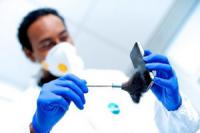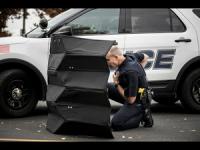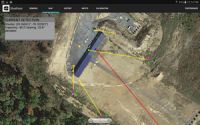-
Second judge approves settlement on NYPD Muslim surveillance
The second of two federal judges has approved a settlement with the New York City Police Department that protects New York Muslims and others from discriminatory and unjustified surveillance. The new rules govern when and how investigations are conducted, and provide for an independent civilian representative inside the NYPD who will act as a check against surveillance abuses.
-
-
NSF-funded research continues to support national security
The National Science Foundation (NSF) is usually associated with supporting scientists who go on to win Nobel Prizes, leading exploration of the planet’s polar regions, and enabling discoveries about the universe, from the subatomic world to distant galaxies. But the foundation also has ties to national defense that go back to its beginnings, as a product of the U.S. government working to enhance security during and after the Second World War. The National Science Foundation Act of 1950 called for the creation of an agency to “promote the progress of science; to advance the national health, prosperity, and welfare; and to secure the national defense.” NSF’s founder, Vannevar Bush, said: “It has become clear beyond all doubt that scientific research is absolutely essential to national security.”
-
-
New technique reveals a suspect's age by analyzing blood splatters
Researchers have discovered a new method of forensic analysis which could more accurately predict the age of criminal suspects based on samples of blood and saliva found at crime scenes. The study tested a technique which uses a form of artificial intelligence or “machine learning” to analyze a specific set of biomarkers in blood samples. The researchers were able to accurately predict the age of sample donors to within four years on average.
-
-
Crime scene fingerprints can move away from the original mark

New research has discovered that crime scene fingerprints can move after they have been deposited. The project, found a thin layer of material from a print can migrate across surfaces away from the original mark. Over a period of up to two months that material, around four millionths of a millimeter thick, will spread away from deposited fingerprint ridges, depending on the host surface.
-
-
No wiretapping at Trump Tower: Senate, House intelligence leaders

Richard Burr (R-N.C.) and Mark Warner (D-Va.), the top two lawmakers on the Senate Intelligence Committee, on Thursday issued a statement to confirm that there is no evidence to back President Donald Trump’s assertion that Trump Tower was under surveillance. On Wednesday, Devin Nunes (R-Calif.) and Adam Schiff (D-Calif.), the leaders of the House Intelligence Committee, said there was no proof Trump was wiretapped during the administration of Barack Obama.
-
-
U.K. intel agency dismisses claim it helped wiretap Trump as “utterly ridiculous”
High-level British intelligence officials have angrily rejected an allegation that the U.K. intelligence service helped former president Barack Obama “wiretap” Donald Trump during the 2016 election. White House press secretary Sean Spicer repeated the claim in his Thursday press briefing. A spokesperson for the U.K. intelligence service dismissed Spicer’s claim as “utterly ridiculous.” A spokesman for Prime Minister Theresa May said on Friday: “We’ve made clear to the administration that these claims are ridiculous and should be ignored.”
-
-
If surveillance cameras are to be kept in line, the rules will have to keep pace with technology

The growing prevalence of cameras and greater understanding of the many ways in which we are surveilled has led many – including the current commissioner, Tony Porter, to voice concern that Britain is “sleepwalking into a surveillance state”. This raises critical questions about whether we can be confident that all these cameras are being used in a way the public would approve of – and if not, whether regulation can force CCTV operators into line. In the future, surveillance camera processes will become more opaque, more sophisticated, and potentially integrated with data from a variety of sources, including social media, meaning decisions about who to survey and who determines intensive surveillance will be determined by big data and algorithms. Any regulatory framework that does not or cannot keep up with the pace of change will soon become worthless.
-
-
The WikiLeaks CIA release: When will we learn?

This week’s WikiLeaks release of what is apparently a trove of Central Intelligence Agency information related to its computer hacking should surprise no one: Despite its complaints of being targeted by cyberattackers from other countries, the U.S. does a fair amount of its own hacking. Multiple federal agencies are involved, including the CIA and the National Security Agency, and even friendly nations. These latest disclosures also remind us of the cybersecurity truism that any electronic device connected to a network can be hacked. If the United States is going to be successful at securing its crucial government information, it must do a better job managing the volume of information generated and controlling access to it, both authorized and otherwise. Granted, neither is an easy task. However, absent fundamental changes that fix the proverbial cult of classification, there likely will be many more WikiLeaks-type disclosures in the future.
-
-
Aging affects the performance of automatic facial recognition systems

Images of our faces exist in numerous important databases – driver’s license, passport, law enforcement, employment – all to accurately identify us. But can these images continue to identify us as we age? Biometrics experts set out to investigate what extent facial aging affects the performance of automatic facial recognition systems and what implications it could have on successfully identifying criminals or determining when identification documents need to be renewed.
-
-
Bulletproof origami shield to protect law enforcement

Engineering professors have created an origami-inspired, lightweight bulletproof shield that can protect law enforcement from gunfire. The new barrier can be folded compactly when not in use, making it easier to transport and deploy. When expanded — which takes only five seconds — it can provide cover for officers and stop bullets from several types of handguns. The ballistic barrier is made of twelve layers of Kevlar.
-
-
TSA continues to use unscientific, unreliable program blamed for profiling
Thousands of Transportation Security Administration (TSA) officers use so-called “behavior detection” techniques to scrutinize travelers for yawning, whistling, being distracted, arriving late for a flight, and scores of other behaviors that the TSA calls signs of deception or “mal-intent.” The officers then flag certain people for additional screening and questioning. Documents the ACLU has obtained through a Freedom of Information Act lawsuit show that the TSA itself has plenty of material showing that such techniques are not grounded in valid science — and they create an unacceptable risk of racial and religious profiling. Indeed, TSA officers themselves have said that the program has been used to do just that.
-
-
Sandia adds augmented reality to training toolbox
When you hear the term “serious gaming” you might envision professional eSports competitors gearing up for a League of Legends World Championship in front of tens of thousands of live fans and tens of millions of streaming fans. At Sandia National Laboratories, serious gaming means something else entirely. Experts on physical security at Sandia apply the technology and methods of the game industry to real-world national security problems.
-
-
Public view of police and body-worn cameras
With heightened public and media interest, there is a national push to expand the use of body-worn cameras (BWCs) by law enforcement. However, there is limited research and only anecdotal evidence suggesting that the public supports the use of these cameras in policing. A new study reveals general public perceptions with some unexpected results.
-
-
Gunshot localization system improves emergency services response to active shooter events

Kathleen Griggs is president of Databuoy. Databuoy Corporation began in 2006 as a defense contracting company specializing in event-driven command and control operations. It has now realigned itself to focus on public safety in the private sector. Databuoy Corporation’s ShotPoint gunshot localization system is a technology aiming to improve the response of emergency services to an active shooter event. ShotPoint uses networked acoustic sensors that automatically detect, locate, and reports the exact time and location of the source of gunfire.
-
-
Anti-surveillance clothing blocks security cameras’ facial-recognition software
New anti-surveillance clothing has been developed, allowing wearers to prevent security cameras which use facial recognition technology from recognizing them. The clothing uses complex colored patterns of digitalized faces, and parts of faces, to overload and trick facial recognition software.
-
- All
- Regional
- Water
- Biometrics
- Borders/Immig
- Business
- Cybersecurity
- Detection
- Disasters
- Government
- Infrastructure
- International
- Public health
- Public Safety
- Communication interoperabillity
- Emergency services
- Emergency medical services
- Fire
- First response
- IEDs
- Law Enforcement
- Law Enforcement Technology
- Military technology
- Nonlethal weapons
- Nuclear weapons
- Personal protection equipment
- Police
- Notification /alert systems
- Situational awareness
- Weapons systems
- Sci-Tech
- Sector Reports
- Surveillance
- Transportation
Advertising & Marketing: advertise@newswirepubs.com
Editorial: editor@newswirepubs.com
General: info@newswirepubs.com
2010-2011 © News Wire Publications, LLC News Wire Publications, LLC
220 Old Country Road | Suite 200 | Mineola | New York | 11501
Permissions and Policies
Editorial: editor@newswirepubs.com
General: info@newswirepubs.com
2010-2011 © News Wire Publications, LLC News Wire Publications, LLC
220 Old Country Road | Suite 200 | Mineola | New York | 11501
Permissions and Policies
